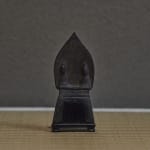Two Seated Buddhas
Taiping 2 (410)
Sealed by Luo Zhenyu on the protective plate in the box
W6.5 x H14.8 cm (incl. stand)
Sealed by Luo Zhenyu on the protective plate in the box
W6.5 x H14.8 cm (incl. stand)
Further images
Provenance
Collection of Luo Zhenyu
The year “Taiping 2” is inscribed on the pedestal. There is no gilding, while the facial expressions and several other parts have worn away, but the mandorla still rises up in a sharp, unconstrained fashion to imbue these small Buddhas with a solemn dignity. “Taiping” was an era name used in Northern Yan, one of the states from China’s Sixteen Kingdoms period. It corresponds to 410 in the Western calendar.
The image seems to represent a scene from Chapter Eleven of the Lotus Sutra, whereby a treasure stupa rises up from the earth, with Prabhutaratna and Sakyamuni sat side by side inside. As such, the image is generally called “Two Seated Buddhas.” The rear side features a line engraving of a solitary deity. Many similar objects were made during the Northern Wei dynasty, from the late fifth century to the early sixth century, which suggests they were created for the general populace.
The box has a padded protective inner plate that fits under the main lid. This bears the seal of Luo Zhenyu, a leading authority on oracle bone studies, together with a message about how he treasured this rare work from the Northern Yan period. After the Xinhai Revolution, Luo came to Japan with the support of his old friend Naito Konan. He stayed in Kyoto and also became close friends with Kano Kunzan. It is likely this statuette’s voyage to Japan was also a product of these friendships. There are also some characters engraved on the box’s lid. These contain the pseudonym of Liu E (courtesy name Tieyun), a collector and author during the late Qing period and a mentor to Luo Zhenyu in the field of oracle bone studies. This suggests the work belonged to Liu E before coming into Luo’s possession.
The image seems to represent a scene from Chapter Eleven of the Lotus Sutra, whereby a treasure stupa rises up from the earth, with Prabhutaratna and Sakyamuni sat side by side inside. As such, the image is generally called “Two Seated Buddhas.” The rear side features a line engraving of a solitary deity. Many similar objects were made during the Northern Wei dynasty, from the late fifth century to the early sixth century, which suggests they were created for the general populace.
The box has a padded protective inner plate that fits under the main lid. This bears the seal of Luo Zhenyu, a leading authority on oracle bone studies, together with a message about how he treasured this rare work from the Northern Yan period. After the Xinhai Revolution, Luo came to Japan with the support of his old friend Naito Konan. He stayed in Kyoto and also became close friends with Kano Kunzan. It is likely this statuette’s voyage to Japan was also a product of these friendships. There are also some characters engraved on the box’s lid. These contain the pseudonym of Liu E (courtesy name Tieyun), a collector and author during the late Qing period and a mentor to Luo Zhenyu in the field of oracle bone studies. This suggests the work belonged to Liu E before coming into Luo’s possession.





